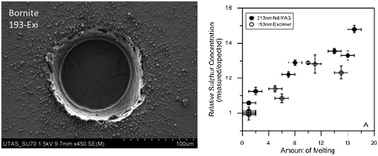Fractionation of sulphur relative to iron during laser ablation-ICP-MS analyses of sulphide minerals: implications for quantification†
Abstract
In this study we investigate the effect that the mineral composition has on the quantification of sulphur by Laser Ablation ICP-MS (LA-ICP-MS) between a range of sulphide minerals: pyrite, pyrrhotite, bornite, chalcopyrite, sphalerite, pentlandite and tetrahedrite. The amount of S fractionation, relative to Fe, was compared between three different nano-second pulse width laser ablation systems: a 213 nm Nd:YAG, a 193 nm Nd:YAG and a 193 nm excimer. Significant matrix effects were seen for some minerals. With the 213 nm Nd:YAG laser, the yield (sensitivity per µg g−1) of S relative to Fe is up to 50% higher for tetrahedrite and approximately 30% higher for bornite and chalcopyrite when compared to the yields of pyrite, whereas no fractionation was seen between Cu and Fe. For analyses on a fixed position on the sample, significant down-hole fractionation (DHF) occurred where S/Fe ratios increased during an analysis. The rate of DHF is also mineral specific, enhancing the need for matrix matched standards for accurate S analysis. The ablation properties of the minerals were also investigated by characterising the shape of the ablation craters and the composition and morphology of the deposited aerosol material around the ablation site using a field emission scanning electron microscope (FE-SEM). At fluences below 3.5 J cm−2, pyrite is ablated efficiently by all laser systems with minimal melting around the ablation site, producing steep sided ablation craters. However, some melting occurs in and around the craters for most other sulphide minerals. The amount of melting is mineral specific and primarily dependent on its physical properties (e.g., bond strength and melting point). The greater the extent of melting, the more S fractionation occurs, consistent with the higher volatility of S relative to Fe.

- This article is part of the themed collection: Geological applications of laser ablation

 Please wait while we load your content...
Please wait while we load your content...